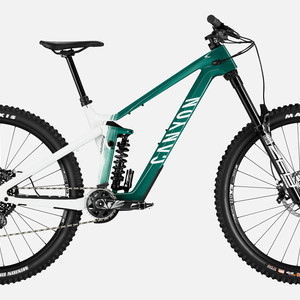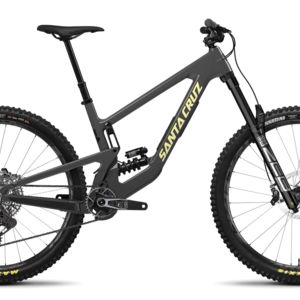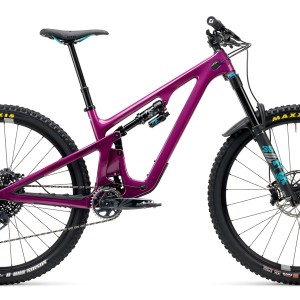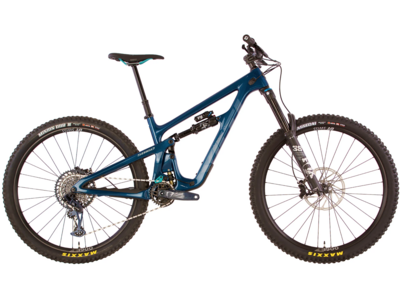2017 Trek Remedy 9.9 Race Shop Limited
(discontinued)
| Where To Buy | |||
|---|---|---|---|
Free standard shipping on all bikes (continental U.S. only).
Flat rate shipping to Hawaii and Alaska. |
|||
Free shipping on orders over $50 (continental U.S. only).
International shipping available. Some exclusions apply. |
|||
Free shipping on orders over $50 (continental U.S. only).
International shipping available. Some exclusions apply. |
|||

In mid-2016, Trek surprised many by killing off the widely-loved Slash 27.5 all-mountain/enduro bike. To fill the newly created void for a long-travel, ready-for-anything 27.5 rig, the all-new Remedy stepped up with a touch more travel at 150mm, completely revised geometry, and a host of fresh features claimed to improve the ride. Part Remedy, part Slash, it's aggressive enough that many of Trek's testers lovingly referred to the new bike as the "Rash" prior to its launch. We were eager to get this potential heavy-hitter back in some wild terrain following our limited time on the bike when it was first introduced in Squamish, British Columbia. To do that we headed to Tucson, Arizona during the 2017 Vital MTB Test Sessions to see how it would perform on one of the rowdiest consecutive series of trails in the States.
Highlights
- Full carbon frame
- 27.5-inch (650b) wheels
- 150mm (5.9-inches) of rear wheel travel // 130/160mm (5.1/6.3-inches) fork travel
- Full Floater suspension design with Active Braking Pivot (ABP)
- Metric RE:aktiv rear shock
- Straight Shot downtube
- Knock Block steerer stop
- E2 tapered headtube
- Internal cable routing
- Press Fit 92 bottom bracket shell with ISCG05 mounts
- Boost 148mm rear spacing with 12mm through axle
- Measured weight (size 18.5, no pedals): 28.3-pounds (12.85kg)
- MSRP $7,999 USD
Many of you will recall the Remedy of old with 140mm of travel and roots firmly in the trail bike realm. The bike now suits a wider range of terrain thanks to a more aggressive attitude with 10mm of extra travel, a slacker head angle, extended reach measurements, and improved component selections across the various builds.

Never one to shy away from trying something new in the suspension realm, Trek's F1-racing-inspired RE:aktiv technology now comes packaged inside the RockShox Deluxe RT3 shock bolted to the frame. In a race car application, regressive damping similar to that found in RE:aktiv shocks is designed to be firm when cornering but supple for sudden impacts. When applied to mountain bikes the goal is similar - to provide support when pedaling or pumping but open up when needed. RE:aktiv was designed to be very sensitive to shaft speeds and it responds accordingly. "What inertia valves attempted for years has finally been realized," Trek claims. "The RE:aktiv ride is firm under pedaling efforts, but provides a smooth, instantaneous transition to plush control, giving you confidence to ride your bike as it should be ridden."
The move to Metric-sized shocks makes sense for Trek, who had already been applying a similar "more room for more cool stuff" theory in their prior shock collaborations with FOX. The new air springs also replicate similar spring curves to Trek's DRCV. Trek maintains the use of their concentric Active Braking Pivot at the rear axle and Full Floater suspension design. While the 230x57.5mm shock isn't a widely available size, the custom stroke can be achieved through the use of travel reducer spacers.
One of the biggest changes to the bike is the new Straight Shot downtube design. Trek's battle to keep weight down while maintaining frame stiffness led them to eliminate the traditional gooseneck shape that typically allows the fork to clear the downtube. The new downtube design is not only visually massive, but also results in the Remedy measuring stiffer at the headtube and bottom bracket than the previous 2016 Slash and Remedy 27.5, with very notable claimed improvements in the bottom bracket area.
|
|
|
|
Because the fork will no longer clear the downtube, a new integrated Knock Block steering stop protects it from damage. It uses a keyed stem, custom headset spacers, custom keyed headset top cover, and a replaceable stop chip in the top tube to prevent the bars from spinning too far. There's also a molded guard on the upper downtube as a redundant measure. A less obvious benefit is that it prevents brake and shift levers from scratching the top tube. Does this introduce some complication? You bet. Those looking to run a non-Bontrager stem will need to use a specially designed keyed headset spacer that clamps to the steerer tube.
Extra details include Trek's easy-to-use Control Freak cable management system which features large internal cable ports and a clever zip-tie slot on the downtube to hold cables secure inside the frame. You'll also find cleanly integrated Carbon Armor and a sizable downtube guard, bottle mount in the front triangle, Press Fit 92 bottom bracket, ISCG 05 tabs, and Boost 148/110mm axle spacing to aid with wheel stiffness and shorter stays. Mud clearance is good with ~15mm of room for buildup with the stock 2.4-inch Bontrager rear tire.
Trek aims to please by offering the new Remedy in five models ranging from $2,999 to $7,999, three of which are alloy and two are carbon. On the Women's side there are two additional Remedy models to chose from. Those looking to get extra rowdy will be interested in Trek's Remedy 9 and 9.9 Race Shop Limited (RSL) builds which feature 10mm longer 160mm travel forks and more aggressive tires. We tested the $7,999 Remedy 9.9 RSL with a full OCLV carbon rear end that provides a sizable weight reduction and makes the bike 1X drivetrain specific. Carbon and alloy frames are also available for $3,299 and $1,889, respectively.
Geometry


Trek's Mino Link is back again, allowing for quick geometry adjustments thanks to a flip chip at the top of the seatstays. Looking at the numbers you can immediately see the Slash's influence coming into play, as the new 150mm travel Remedy RSL build sports a slack 65.5-degree head angle in the 'Low' geometry setting, over 10mm longer reach values across the size range, and lower bottom bracket heights.
With five sizes to choose from there's something for just about every rider height. Thanks to low standover heights, fit is good for short riders. Our 5'8" and 5'10" (1.73 and 1.78m) tall testers opted for the size 18.5 with a healthy reach of 439mm and a measured bottom bracket height of 335mm in the 'Low' geometry setting.
Suspension Analysis
Using the bike industry's leading linkage analysis software, André Santos, the Youtube suspension whiz, was able to determine a close approximation of the Remedy's kinematics for the purpose of this review. These charts provide great insight into several key factors that impact how it rides. Those unfamiliar with these types of graphs should watch André's excellent series of suspension fundamentals videos. The results of his analysis are as follows:
|
|
|
|
Observations:
- The Trek Remedy has enough progressivity for a 150mm travel enduro bike at 24%.
- It works as a single pivot regarding pedaling characteristics. Since the main pivot is located near the top of chainring, the pedaling efficiency is good with anti-squat values around 90% in all cogs for a 32-tooth chainring. With a 30-tooth chainring the anti-squat values increase to 100%.
- Given the relatively constant anti-squat values on the whole travel, total pedal kickback is relatively high.
- Anti-rise of 50% at sag, meaning that the brake caliper doesn’t rotate much around the disc when the suspension compresses. Therefore the suspension is relatively isolated from braking forces.
- Overall, the Remedy is a moderately progressive enduro bike with good pedaling efficiency and relatively neutral braking.
How does science meet the dirt? Did our real life ride time confirm the analysis? It's back to Vital's testers to hear how the new Remedy performed on trail.
On The Trail
To put the new Trek Remedy to the test, we headed to Tucson, Arizona to ride the relentlessly rocky and incredibly rough trails on Mount Lemmon. Our rides included Bug Springs, Prison Camp and La Milagrosa, some of which require an incredible amount of bike handling skill to navigate successfully. The trails feature very technical sections at all points during the 5,400-feet of descending. It's not just all down though, with around 2,000-feet of technical climbing to get to the goods. As is common in the Arizona desert, conditions were dry with loose marbly rocks over hard-packed soil interspersed with decomposed granite.
Setup was straightforward as Trek provides recommended air spring pressure settings for both the fork and rear shock. After a quick two-minute Mino Link flip to the slacker geometry setting, we initially set the rear to 190psi as suggested for a 180-pound test rider and verified that it gave us close to 28% (16mm) sag. We then added 85psi up front as noted by RockShox for the Lyrik RCT3 Dual Position Air fork. Note that Trek suggests 105psi for this fork for a 180-pound rider which is far too much and should be corrected in their system.
Despite having an odd look that makes finding the perfect bar roll difficult, the stock 780mm wide Bontrager Line Pro handlebar provided a comfortable feel with plenty of adjustment range for those preferring a slightly narrower bar. While we'd prefer to see handlebars with a bit more rise to them, there's plenty of steerer tube left for adjustments if needed. We were pleased to see it come with a 50mm Bontrager Line Pro stem.

Riding the Remedy, the biggest thing that strikes you is that it's just plain fun. The bike has a remarkably light feel to it, is easy to ride, and encourages you to play. Frame stiffness shines through in a very positive way while pumping the trail. Combining the Straight Shot downtube system with good suspension performance and a solid set of wheels, you're met with a bike that feels both incredibly precise yet is able to calm the terrain. Pressing into it results in a nice burst of speed that's easy to maintain.
The comfortable feel encouraged us to find our way into bonus lines and pop off random lips at a moment's notice, at times allowing us to get away from some stuff that maybe we shouldn't be able to. One tester completely threw caution to the wind while riding this bike by sprinting into flatter gnar and landing in bomb holes, never exceeding its capability or feeling like he was in over his head.
Riding the Remedy, the biggest thing that strikes you is that it's just plain fun. The bike has a remarkably light feel to it, is easy to ride, and encourages you to play.
Entering steeper, steppier terrain, both testers noted a suspension imbalance. Our shorter tester noted it first as the bike felt bigger to him and exaggerated the situation. Prior to the addition of two Bottomless Tokens we were all over the front end at times and the bike felt steeper than the numbers would indicate. Luckily it's now possible to add Tokens to RockShox's Dual Position Air forks. The RockShox Lyrik also settles into the travel more than most forks due to a larger negative air spring, with both riders noting the lower ride height. Adding low-speed compression helped control this a bit, with one of our testers running the fork just two clicks out from full firm. Due to the RE:aktiv damping system in the rear shock, the front and back don't always feel as though they have the same rate, but this seemed best for overall balance. Adding a 10mm shorter stem was also key for our shorter tester to find his comfort zone.
Once we dialed in the fork's air spring and compression settings, front to back balance was good and at no point did we feel slighted or really thrown off by the way the bike reacted. This allowed us to focus solely on the terrain, trying even bolder lines and optional gaps along the way. We've previously remarked about how certain bikes have a very "quiet" sense to them, and this bike achieves that in a big way. Braking is calm and neutral.

On back-to-back days with longer travel enduro race bikes, the Remedy proved to be a very good contender by besting their performance in some instances. The bike felt like it had more than 150mm of travel in the rough, never bottoming harshly or attempting to squirt out from under us on big compressions, g-outs, or drops.
The combination of the new Metric shock and Trek's RE:aktiv technology yields great small bump performance thanks to increased bushing overlap and bearings in the upper shock mount, as well as good pedaling and pumping performance. It does a very good job of maintaining composure over repeat square edges and chatter. We experienced no issues with pedal kickback.
We've previously remarked about how certain bikes have a very "quiet" sense to them, and this bike achieves that in a big way.
Jumping the bike felt very controlled most times, but we did notice the shock handling some jumps differently depending on lip shape and entrance speed. Though a notable improvement over Trek's previous FOX collaborations, pushing into some jump faces makes the rear use a lot of travel when it overcomes the shaft speed threshold of the RE:aktiv system.
Another highlight was its ability to track well through a variety of terrain types. Having ridden the bike in both rainy spring British Columbia conditions and Tucson's loose, rocky mountains, we were impressed by its ability to maintain composure in both extremes. The progressive suspension feel provides loads of support when it matters most, it's supple off the top when it needs to be, and traction was no issue even in the wet.
While some riders will bummed that their x-up, bar-spin, and Schleybletop game just took a major hit, we were pleased to find that the Knock Block system goes unnoticed on the trail, even in tight turns.
Those trail bike roots show through in a positive way when pointed uphill, with the RE:aktiv technology making it easier to ride and an ability to disguise a bit of poor pedaling technique. The bike feels more efficient on the climbs without the use of a shock lever while still providing ample amounts of traction. Its perceived weight is also a little lower than it rings up on the scale, which is saying a lot since the bike weighs in at just 28.3-pounds (12.85kg). When you sprint it's quick to respond with a minimal loss of power.
Those trail bike roots show through in a positive way when pointed uphill, with the RE:aktiv technology making it easier to ride and an ability to disguise a bit of poor pedaling technique. The bike feels more efficient on the climbs without the use of a shock lever while still providing ample amounts of traction.
Even in Tucson's rocky terrain, we had relatively few issues with pedal clearance in the 'Low' geometry setting thanks to the bike's firmer feel under power. We experienced no front-end pushing despite the slack head angle and we're impressed by the bike's ability to climb quickly over techy terrain. So, is the Dual Position Air fork needed for the climbs? It's an unnecessary feature given the excellent performance we saw while climbing with the fork fully extended.
Build Kit
The Remedy 9.9 RSL is built to party and comes complete with a mixture of parts from SRAM, RockShox, and Bontrager, Trek's component company. The RSL designation indicates that it's a "pro-level build" and features an additional 10mm of travel up front and tires with a burlier casing. While comparable in terms of quality, some would contend that at $7,999 you're paying a very sizable chunk of change for several house-brand parts with no major performance advantage.
|
|
|
|
Though we've already discussed some traits of the RockShox Lyrik and made a case for why the Dual Position Air version isn't needed, the fork does add to the ride in several positive ways. It offers excellent terrain sensitivity thanks to smooth off-the-top performance, easy air spring tuning, and a stiff chassis that aids this bike's precise front end feel.
Bontrager's 2.4-inch SE4 Team Issue tires are tubeless ready with stouter Core Strength sidewalls on this build. The SE4 is decent all around but exhibits a bit of a bulbous/balloony feel. The tires wanted to roll over at times versus really digging into the dirt despite being paired with 28mm internal width rims and pressures around 30psi. Knowing the amazing handling, cornering traction, and improved damping offered by Bontrager's SE5 tire, we can't help but wish it was included on at least the front of this bike.
The Line Elite 30 wheels from Bontrager offer a very comfortable and stout ride, come with tubeless strips pre-installed, and the 54-tooth Rapid Drive rear hub adds to the experience with minimal drag. Following our time in Tucson the rear wheel only had a slight wobble which points to good durability.
SRAM's Guide Ultimate brakes provided plenty of stopping power and great modulation with dual 180mm rotors, as well as easy lever adjustments for a personalized feel.

Drivetrain duties are handled by SRAM's X01 Eagle drivetrain, which is quickly becoming a favorite among Vital testers. Not simply one more gear, it's a better 1X drivetrain all around. In addition to smoother shifting than SRAM's 1x11 drivetrains, the 12-speed Eagle cassette has more range and the 32-tooth chainring wears far better. While riding this bike we also noted how good Eagle is at dumping gears when surprised with a steep climb. Combined with the integrated Carbon Armor guards and silent cable routing system, Eagle's clutch helps make this bike near silent.
We initially found the new cable-actuated, air-sprung, and infinitely-adjustable Bontrager Drop Line seatpost to be pretty dang impressive with smooth and precise movement. It's a little limiting at 125mm of travel, however, especially for taller riders. The post also began to get sticky after just a handful of rides. It was joined by a very comfortable Bontrager Evoke 3 saddle with titanium rails.
Long Term Durability
Looking the Remedy over, four items jump out as potential areas for concern in the durability department. The Bontrager Drop Line seatpost showed early signs of stiction, the custom RE:aktiv shock is a bit harder to service or replace than most, the aluminum Knock Block system could be ineffective in a big crash, and, although we didn't experience it on this bike, Press Fit bottom brackets have been known to creak over time.
That said, there are a lot of good things going for this ride. The frame is stout all around, bearings are sealed and easily replaceable, carbon construction looks great, and there's a larger downtube guard than most. Trek backs the front triangle with a lifetime warranty, swing arm for five years, and Bontrager components for two years.

What's The Bottom Line?
Trek's Remedy has finally arrived. This is arguably the best bike Trek has ever made for our riding style and preferred types of pedally terrain. Once the fork settings are sorted, it provides a balanced, supported suspension feel that helps you maintain composure in moments when the trail is doing its best to fight against you. The bike's quiet demeanor through the rough stuff is complemented by a stiff frame and unique suspension technology that helps make it a playful rider's dream. It truly deserves the all-mountain designation as it's a proficient climber, ready to tackle rowdy descents, and is quick in between. From the sopping wet trails of Squamish to the chunky desert smash fest in Tucson, the Remedy impressed us across a wide variety of terrain. One bike to do it all, you ask? This easy-to-ride, light, and fun machine may be the ticket for a lot of riders.
Visit www.trekbikes.com for more details.
Vital MTB Rating
- Climbing: 4.5 stars - Outstanding
- Descending: 4 stars - Excellent
- Fun Factor: 5 stars - Spectacular
- Value: 3.5 stars - Very Good
- Overall Impression: 4.5 stars - Outstanding
Bonus Gallery: 25 photos of the 2017 Trek Remedy 9.9 Race Shop Limited up close and in action
About The Reviewers
Steve Wentz - Age: 32 // Years Riding MTB: 20 // Height: 5'8" (1.73m) // Weight: 178-pounds (80.7kg)
"Despite what it looks like, I'm really precise and calculated, which I'm trying to get away from. I'm trying to drop my heels more and just let it go." Steve is able to set up a bike close to perfectly within minutes, ride at close to 100% on new trails and replicate what he did that first time over and over. He's been racing Pro DH for 14+ years including World Cups, routinely tests out prototype products, and can squish a bike harder than anyone else we know. Today he builds some of the best trails in the world.
Brandon Turman - Age: 30 // Years Riding MTB: 16 // Height: 5'10" (1.78m) // Weight: 175-pounds (79.4kg)
"My current riding joys include pulling up hard and hucking test bikes into poor landings and techy sections with reckless abandon, then seeing how they react upon landing." Formerly a Mechanical Engineer and Pro downhill racer, Brandon brings a unique perspective to the testing game as Vital MTB's resident product guy. He has on-trail familiarity with nearly every new innovation in our sport from the past several years and a really good feel for what’s what.

About Test Sessions
For five years a dedicated crew of Vital MTB testers have been bringing you the most honest, unbiased reviews you'll find anywhere. This time around we rode 2017's most exciting trail, all-mountain, and enduro bikes on a wide variety of rowdy trails in Tucson, Arizona. Reviews can be accessed 24/7 in our Product Guide. Test Sessions was made possible with the help of Arizona Cyclist. Tester gear provided by Troy Lee Designs, Specialized, Five Ten, ZOIC, Sombrio, Race Face, and EVOC. All photos by Lear Miller.
Specifications
Active Braking Pivot
| Where To Buy | |||
|---|---|---|---|
Free standard shipping on all bikes (continental U.S. only).
Flat rate shipping to Hawaii and Alaska. |
|||
Free shipping on orders over $50 (continental U.S. only).
International shipping available. Some exclusions apply. |
|||
Free shipping on orders over $50 (continental U.S. only).
International shipping available. Some exclusions apply. |
|||

































10 comments
Post a reply to: Review - 2017 Trek Remedy 27.5 from Vital MTB Test Sessions